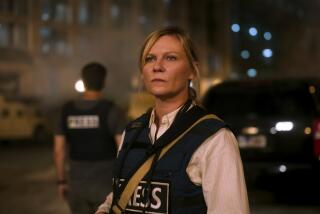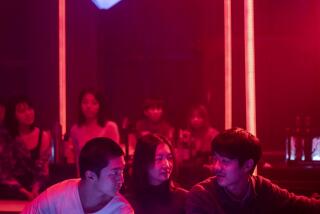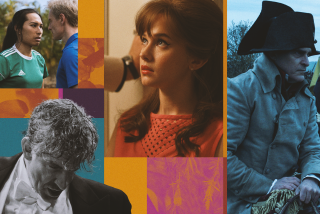WHAT WOMEN FLIP OVER
Films we can categorize, that’s what we’re used to. Good or bad, fiascoes or masterpieces, we put them in their place, every one. What we’re not used to, what we haven’t had much of at all, are films that transcend categorization, that remind us--simply, powerfully, indelibly--what we go to the movies for. Ang Lee’s “Crouching Tiger, Hidden Dragon” is that kind of a picture.
A delightful one-of-a-kind martial arts romance where astounding fight sequences alternate with passionate yet idealistic love duets, “Crouching Tiger” is a fusion film from top to bottom. By joining emotional sophistication to the most thrilling kind of Hong Kong-style acrobatic action, by having classical cellist Yo-Yo Ma and preeminent fight choreographer Yuen Wo-Ping in the same film, “Crouching Tiger” brings a specific national cinema fully into the world spotlight. It can do all this so successfully because Lee reconciles these opposites in his own life and work.
Lee, who at varying times has called this film “ ‘Sense and Sensibility’ with martial arts” and “Bruce Lee meets Jane Austen,” was born in Taiwan and moved to the U.S. when he was 24. He followed his first three Taiwanese features (the “Father Knows Best”trilogy of “Pushing Hands,” “The Wedding Banquet” and “ Eat Drink Man Woman”) with the English-language trio of “Sense and Sensibility,” “The Ice Storm” and “Ride With the Devil.”
But Lee, now 46, had a childhood dream of making a film based on the wuxia novels and films he grew up with, where the rules of behavior are strict but the laws of gravity do not apply. It’s a Chinese genre about the adventures of Confucian-era wandering warriors described by co-screenwriter and frequent Lee collaborator James Schamus as “knights-errant skilled in martial arts and Taoist spiritual practices [who] fight on behalf of their principles as well as against their own desires.”
It’s a world of hidden identities and mystical situations, of legendary swords and stolen secret manuals that “Crouching Tiger” takes us into, a maelstrom of forbidden loves, bitter rivalries and indomitably heroic looks. With impeccable production and costume design by Tim Yip and sweeping cinematography by Peter Pau (who also did John Woo’s “The Killer”), it’s also a strikingly beautiful world, featuring elaborate costumes and picturesque vistas selected from all across mainland China.
*
It was director Lee who found the 70-year-old Wang Du Lu novel that Schamus, Wang Hui Ling and Tsai Kuo Jung adapted. He was also the person who insisted on a thrilling but almost impossible-to-shoot battle at the tops of bamboo trees and who opted to film “Crouching Tiger” not in the more commercially viable English or the Cantonese of most of his cast but his more lyrical native Mandarin. “Otherwise,” he has said, “it would be like watching John Wayne speak Chinese in a Western.”
The director of “Sense and Sensibility,” concerned in many of his films with women and their options for freedom, was not surprisingly drawn to a story that focuses on women not as objects of romance (though there is that, too) but as fierce and relentless fighters, resourceful and defiant. Three indomitable women are the centerpiece of “Crouching Tiger,” and it would be a mistake to anger any one of them.
Though Lee has admitted to going further with romanticism here than ever before, his natural reserve and discretion as a filmmaker are equally important to “Crouching Tiger’s” success. Rather than start the film with a major action sequence, Lee, sure of what’s in store, has the confidence to carefully set his stage. “Crouching Tiger” gradually widens and expands its vistas, both physical and emotional, continually surprising us by increasing our involvement.
Equally confident is the film’s top-of-the-line cast, though each had a reason not to be. Asian superstar Chow Yun Fat was not only not the director’s first choice (he got the part after action master Jet Li dropped out), he’d also never handled a sword before. Co-star Michelle Yeoh, a martial arts veteran, was hampered for a time by a knee injury and had to do one of her key dramatic scenes with her leg stretched out on an off-camera apple box. And newcomer Zhang Ziyi, recommended to Lee by director Zhang Yimou, was a 19-year-old drama student when she got her part, and needed the permission of her school to accept it.
“Crouching Tiger” starts with a reunion between Yu Shu Lien (Yeoh), the head of a security service, and Li Mu Bai (Chow), the great martial artist of his day, a couple we sense might have more than friendship between them if codes of behavior permitted.
Despite his skill, Li has returned from a meditation retreat determined, like Alan Ladd’s Shane, to put his profession behind him. As a token of this, he asks Yu to deliver his legendary, 400-year-old sword, the Green Dynasty, to a court official named Sir Te in Beijing. Though he regrets not being able to avenge the death of his master at the hands of the sinister Jade Fox (Cheng Pei Pei, a star of 1960s martial arts films), Li feels he has no choice.
When Yu hands over the sword, she meets a beautiful and well-born bride-to-be named Jen (Zhang Ziyi), a prim porcelain doll who says she envies the freedom of the martial arts life women such as Yu enjoy. Yu tries to tell Jen there are obligations as well as adventures to this life, a truth that all the film’s characters get to experience for themselves when the Green Dynasty is mysteriously stolen and the connections between what has happened in the past and what the future might bring come into focus in the battle for its recovery.
Setting “Crouching Tiger” apart from the standard martial arts film is the care both the screenwriters and the actors have taken with the dialogue. Lee fought for this even though he understood it was “almost against nature” because paying attention to language and character might distract an actor and cause an injury during the action sequences.
It is that action everyone will remember most about “Crouching Tiger.” Choreographed by the masterful Yuen Wo-Ping, who brought his decades of expertise to bear on “The Matrix,” the fights feature intricate hand-to-hand combat with a variety of weapons as well as bare hands. Best in show, however, are the airborne battles that particularly characterize the genre.
For it’s one of the givens of these films that great fighters, through a combination of secret manuals and mind control, can literally fly at will. Even when you know this flying effect is created by attaching the actors to steel cables a la Peter Pan and then optically removing the wires, that in no way lessens the breathtaking effect.
Actors move with reality-defying speed and lightness, floating over rooftops and tiptoeing across lakes with unimaginable grace. With its gift for showing things that can’t be described, “Crouching Tiger’s” blend of the magical, the mythical and the romantic fills a need in us we might not even realize we had.
* MPAA rating: PG-13 for martial arts violence and some sexuality. Times guidelines: The violence is more choreographed than brutal.
(BEGIN TEXT OF INFOBOX / INFOGRAPHIC)
‘Crouching Tiger, Hidden Dragon’
Chow Yun Fat: Li Mu Bai
Michelle Yeoh: Yu Shu Lien
Zhang Ziyi: Jen Yu
Chang Chen: Lo
Lung Sihung: Sir Te
Cheng Pei Pei: Jade Fox
In association with Good Machine International, an Edko Films, Zoom Hunt production in collaboration with China Film Co-Production Corp. and Asia Union Film & Entertainment Ltd., a Sony Pictures Classics and Columbia Pictures Film Production Asia presentation, released by Sony Pictures Classics. Director Ang Lee. Producers Bill Kong, Hsu Li Kong, Ang Lee. Executive producers James Schamus, David Linde. Screenplay James Schamus, Wang Hui Ling, Tsai Kuo Jung, based on the novel by Wang Du Lu. Cinematographer Peter Pau. Editor Tim Squyres. Costumes Tim Yip. Music Tan Dun. Production design Tim Yip. Supervising art directors Eddy Wong, Yang Zhan Jia, Yang Xin Zhan. Running time: 1 hour, 59 minutes.
More to Read
Only good movies
Get the Indie Focus newsletter, Mark Olsen's weekly guide to the world of cinema.
You may occasionally receive promotional content from the Los Angeles Times.











